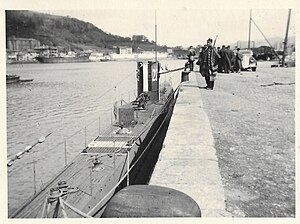 U-27 in Fuenterrabia, Spain (circa. 1938)
| |
| History | |
|---|---|
| Name | U-27 |
| Ordered | 1 April 1935[1] |
| Builder | DeSchiMAG AG Weser, Bremen |
| Cost | 4,189,000 ℛ︁ℳ︁ |
| Yard number | 908[1] |
| Laid down | 11 November 1935[1] |
| Launched | 24 June 1936[1] |
| Commissioned | 12 August 1936[1] |
| Fate | Sunk by British warships, 20 September 1939[2] |
| General characteristics | |
| Class and type | Type VIIA submarine |
| Displacement | |
| Length |
|
| Beam |
|
| Height | 9.50 m (31 ft 2 in) |
| Draught | 4.37 m (14 ft 4 in) |
| Installed power |
|
| Propulsion |
|
| Speed |
|
| Range | |
| Test depth |
|
| Complement | 4 officers, 40–56 enlisted |
| Sensors and processing systems | Gruppenhorchgerät |
| Armament |
|
| Service record[2][3] | |
| Part of: |
|
| Identification codes: | M 08 129 |
| Commanders: |
|
| Operations: |
|
| Victories: |
2 merchant ships sunk (624 GRT) |
German submarine U-27 was a Type VIIA U-boat of Nazi Germany's Kriegsmarine built for service in World War II. Her keel was laid down in November 1935 in Bremen. She was commissioned in August 1936 with Korvettenkapitän Hans Ibbeken in command. Ibbeken was relieved on 4 October 1937, by Johannes Franz, who commanded the boat until 6 June 1939 when Hans-Georg von Friedeburg assumed command for barely one month. He was relieved on 8 July again by Johannes Franz, who commanded the boat until her loss on 20 September 1939.
U-27 had a very short career, with only one war patrol and only two enemy ships sunk. Following the sinking of two British trawlers, Davara on 13 September and Rudyard Kipling on 16 September, U-27 was hunted down and sunk west of Lewis, Scotland, by depth charges from the British destroyers HMS Fortune, Faulknor and Forester. All 38 crewmen survived and were made prisoner for the remainder of the war.
- ^ a b c d e "U-1163 Type VIIA". ubootwaffe.net. Archived from the original on 11 December 2008. Retrieved 30 June 2010.
- ^ a b Helgason, Guðmundur. "The Type VIIA boat U-27". German U-boats of WWII - uboat.net. Retrieved 30 June 2010.
- ^ Helgason, Guðmundur. "War Patrols by German U-boat U-27". German U-boats of WWII - uboat.net. Retrieved 30 June 2010.